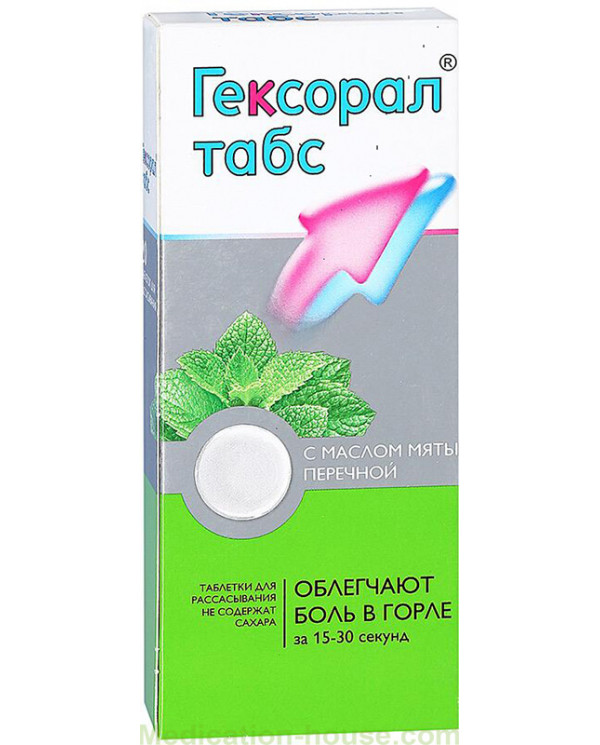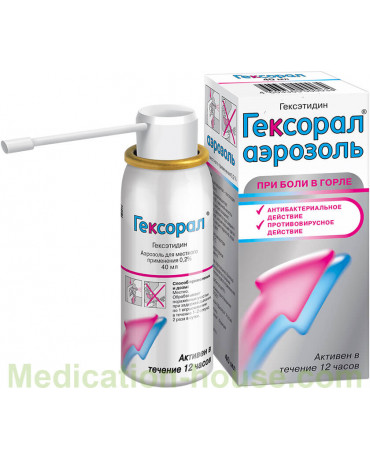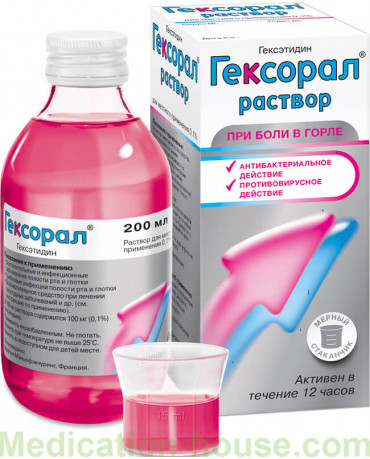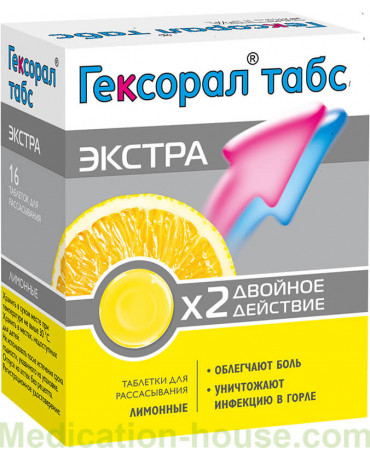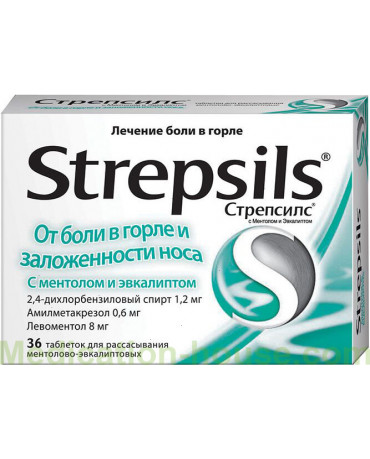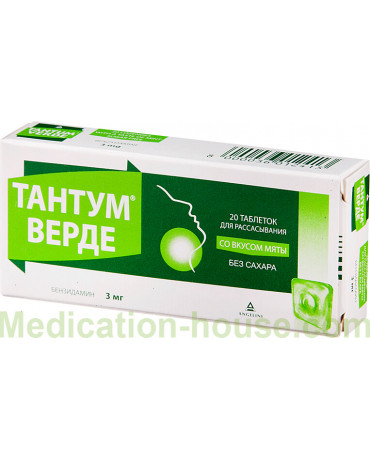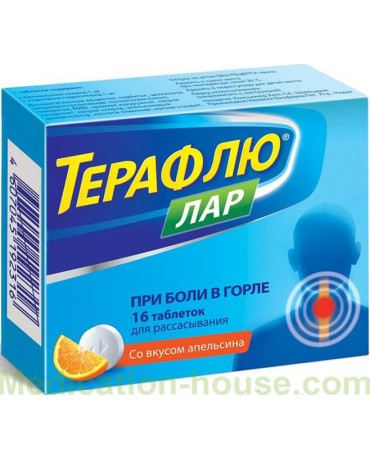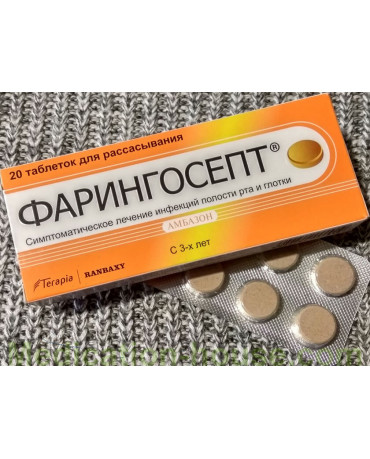Hexoral tabs instruction
You can buy Hexoral tabs here
Release form and composition
Release form Hexoral tabs - lozenges: round, biconvex, with a rough surface, opaque, from white / yellowish white to light gray / yellowish gray; dusting (the appearance of white plaque), slight roughness of the edges, the presence of bubbles and uneven staining (10 pcs. in blisters, 2 blisters in a cardboard bundle) are possible.
Composition 1 tablet:
active substances: chlorhexidine dihydrochloride - 5 mg, benzocaine - 1.5 mg;
additional components: isomalt - 2243.681 mg, purified water - 45.789 mg, aspartame - 2.29 mg, peppermint oil - 0.9 mg, menthol - 0.645 mg, thymol - 0.045 mg.
Pharmacodynamics
The action of Hexoral tabs is due to the properties of the two active substances included in its composition: chlorhexidine - an antibacterial agent, benzocaine - a local anesthetic that reduces pain symptoms.
Chlorhexidine is characterized by a wide antibacterial spectrum of action against gram-positive and gram-negative bacteria. The mechanism of its action is explained by its ability to destroy the cytoplasmic membrane of a bacterial cell. Ineffective for diseases caused by mycobacteria, yeast, dermatophytes, some species of Proteus and Pseudomonas. Most effective in slightly alkaline and neutral environments. Its activity decreases in an acidic environment, in the presence of purulent secretions and blood. Due to the content of chlorhexidine in the tablets for resorption of Hexoral tabs, a significant decrease in the content of bacteria in saliva occurs. With prolonged use, the effectiveness of the substance decreases due to a decrease in the sensitivity of bacteria.
Benzocaine is a common local anesthetic that quickly and permanently relieves pain in the oral cavity and pharynx. The mechanism of its action is due to the ability to penetrate through the lipophilic sections of the cell membrane and act on peripheral pain receptors of the mucous membrane and skin. The analgesic effect of the drug occurs within 15-30 seconds after administration and gradually decreases as the substance is diluted with saliva (within 5-10 minutes).
Pharmacokinetics
There are no clinical data on the absorption of chlorhexidine through the mucous membrane of the oral cavity. In saliva, the substance lasts up to 8 hours.
Benzocaine is characterized by slow absorption, because it is sparingly soluble in water. Like other essential derivatives of para-aminobenzoic acid, it is cleaved by esterase in the liver and blood plasma, resulting in the formation of para-aminobenzoic acid and ethyl alcohol. Para-aminobenzoic acid is conjugated with glycine or excreted by the kidneys unchanged. Ethyl alcohol is metabolized to acetyl coenzyme A.
Indications for use
Hexoral tabs is used to treat infectious and inflammatory diseases of the oral cavity and throat, including stomatitis, pharyngitis, gingivitis, tonsillitis, etc.
Contraindications
ulcerative or wound lesions of the oral cavity / throat;
phenylketonuria;
low concentration of cholinesterase in blood plasma;
children under 4 years old;
hypersensitivity to any component of the drug.
Hexoral tabs should be used with caution and only under medical supervision in case of erosive and desquamative changes in the oral mucosa, as well as in children, in patients with swallowing or aspiration disorders.
Instructions for use Hexoral tabs: method and dosage
Hexoral tabs is applied topically, dissolving tablets in the oral cavity until completely dissolved.
Unless otherwise specified, adults and adolescents from 12 years old should take 1 tablet as needed, at intervals of at least 1–2 hours, but not more than 8 times a day.
Children 4-12 years old are allowed to take no more than 4 tablets per day.
Treatment is recommended to start as soon as possible after the first signs of the disease and continue for several days after the disappearance of unpleasant symptoms.
Side effects
Hexoral tabs is predominantly well tolerated. The following are side effects, which are not possible to assess the incidence of, as they are described in spontaneous reports of adverse reactions:
from the gastrointestinal tract: reversible discoloration of the tongue, formation of plaque (tartar), discoloration of the teeth or silicate and composite materials for tooth restoration, temporary numbness of the tongue, decreased sensitivity and exfoliation of the oral mucosa, stomatitis, taste disturbance (dysgeusia ), an increase in the parotid salivary glands, glossodynia;
from the immune system: hypersensitivity reactions, including anaphylactic reactions, angioedema, urticaria, anaphylactic shock;
from the blood and lymphatic system: methemoglobinemia.
Overdose
If the dosage regimen of Hexoral tabs is observed, an overdose is impossible, since chlorhexidine is practically not absorbed into the blood, and the amount of benzocaine that enters the bloodstream is extremely low.
In addition, chlorhexidine hydrochloride is poorly soluble in water, and known cases of overdose have occurred with chlorhexidine gluconate, which is highly soluble in water. In such patients, mucosal damage occurred (in the case of direct contact with the substance) and a systematic reversible increase in the concentration of liver enzymes. Specific treatment methods have not been developed.
An overdose of benzocaine is possible if it is used improperly. Signs of intoxication: vomiting, tremors, cramps, depression of the central nervous system and breathing, coma. At high toxic concentrations, benzocaine can cause blockade of atrioventricular conduction, bradycardia, and cardiac arrest. There is also a risk (especially in children) of the development of methemoglobinemia, accompanied by cyanosis and suffocation.
In case of an overdose of benzocaine, it is necessary to artificially induce vomiting, rinse the stomach and take activated charcoal. In the case of anoxia and hypoxia, artificial respiration with oxygen support is indicated; when cardiac arrest is carried out its massage; with convulsions (with the exception of anoxic), fast-acting barbiturates or diazepam are prescribed. In especially severe cases, after intubation and artificial respiration, suxamethonium chloride is used. The introduction of solutions of electrolytes or blood plasma supports blood circulation. With methemoglobinemia, intravenous use of a 1% methylene blue solution (up to 50 ml) is possible.
special instructions
Information for patients with diabetes: each tablet contains carbohydrates, the amount of which corresponds to 0.1 bread unit.
In connection with the risk of methemoglobinemia during treatment, special attention should be paid to the possible appearance of symptoms such as fatigue, shortness of breath, headache, pale or discoloration of the lips, nail beds and skin integuments in gray or blue, tachycardia, and fainting. When they appear, the drug should be stopped immediately and consult a doctor, because these signs indicate the presence of a moderate or high amount of methemoglobin and a significant decrease in the oxygen transport function of the blood. In a special risk group are children and elderly patients.
Hexoral tabs is contraindicated in phenylketonuria, because it contains aspartame.
Influence on the ability to drive vehicles and complex mechanisms
The drug does not have the ability to negatively affect the speed of reactions and the ability to concentrate.
Pregnancy and lactation
Due to the lack of sufficient clinical experience with the use of the drug during pregnancy and lactation, Hexoral tabs in these periods can be used for treatment only if the expected benefit exceeds the potential risks to the fetus / child.
Use in childhood
According to the instructions, Hexoral tabs is strictly contraindicated in children under 4 years of age, at an older age, taking the drug is possible only as directed by a doctor, under close supervision of adults.
Use in old age
It should be borne in mind that elderly patients have a higher risk of developing methemoglobinemia while taking the drug.
Drug interaction
Benzocaine reduces the antibacterial effect of aminosalicylates and sulfonamides.
The effect of chlorhexidine with simultaneous use reduces polysorbate 80, sucrose, insoluble salts of zinc, calcium and magnesium.
Terms and conditions of storage
Keep no more than 3 years out of the reach of children at temperatures up to 25 ° C.
Reviews on Hexoral Tabs
Patients taking the drug leave mostly positive reviews about Hexoral tabs. In their experience, the drug quickly and effectively eliminates pain in the mouth and throat, the main condition is to start taking it when the first symptoms of the disease appear.
Additional advantages include the pleasant taste of the tablets and the almost complete absence of side effects, subject to the recommended dosage regimen.
Terms of sell
You can buy Hexoral tabs without a prescription.

